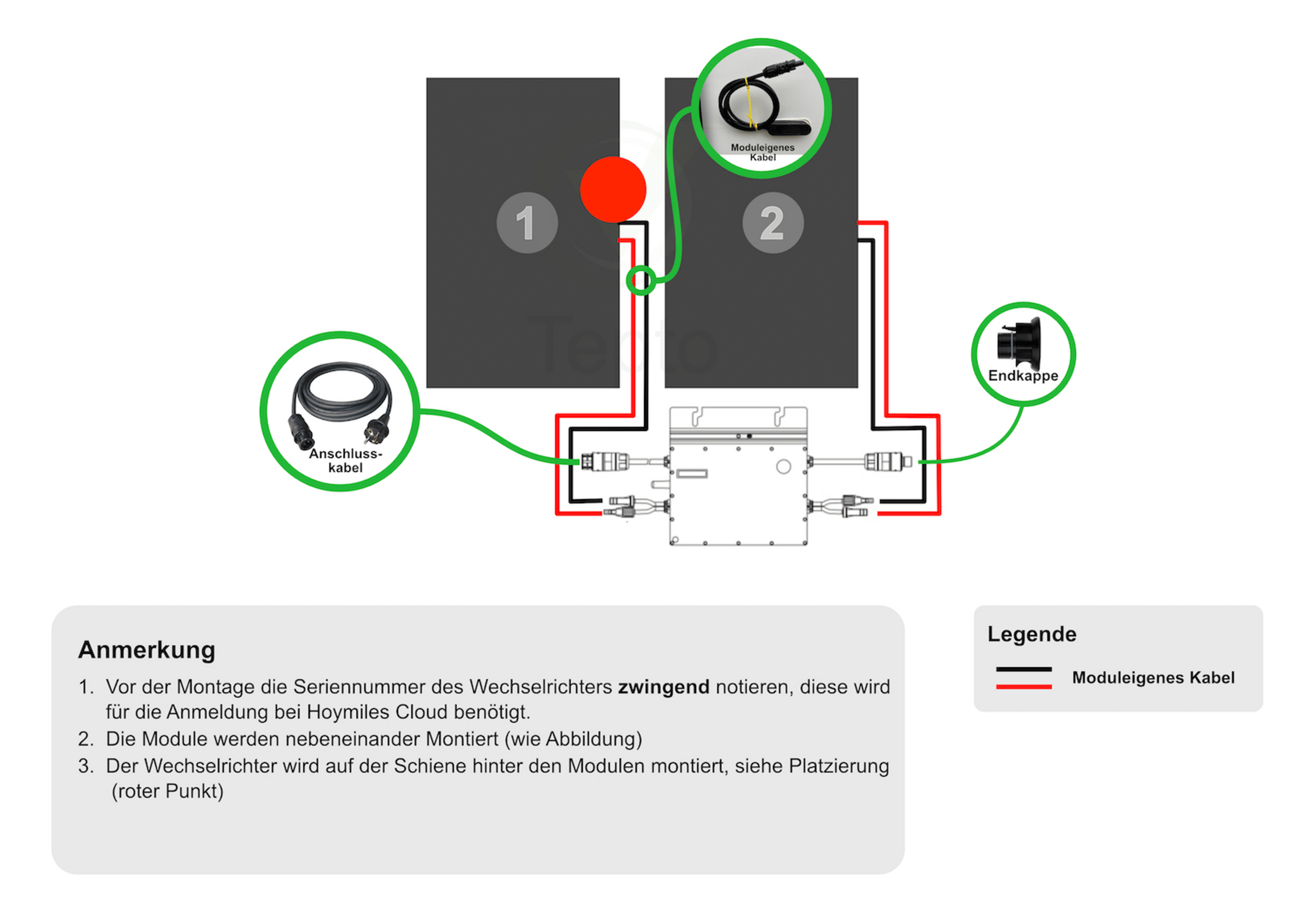Frequently Asked Questions (FAQ)
What is a balcony power plant?
A balcony power plant, also called a plug-in solar device or mini photovoltaic system, uses a photovoltaic module to convert solar energy into electricity.
It is used to efficiently convert solar energy into usable electricity. The size is limited to a maximum of two modules, and the feed-in to the power grid must not exceed 600 watts (800 watts as of 01.01.2024).
These systems are usually connected directly to the house or apartment circuit by plugging them into an electrical outlet. This allows users to use solar energy generated on site to meet their energy needs.
What are the components of a balcony power plant?
1. solar modules: Convert sunlight into electrical energy.
2. microinverters: convert generated direct current (DC) into alternating current (AC) for feeding into the grid.
3. mounting material/mounting system: secure solar modules to the balcony or selected area.
4. cables to the socket: direct the generated power to the socket or to the mains.
These components generate and direct solar energy from the balcony power plant to the grid or for personal use.
Wieland or Schuko plug? Which is the right one?
When choosing a plug for a balcony power plant, there are two options: Schuko plug or Wieland plug. Here are the facts:
A balcony power plant with a standardSchuko plug is just assafe and legal as one with a Wieland plug.
Balcony power plants sold in Germany usually have mains and system protection (NA protection) to prevent voltage when the plug is pulled.
The choice between Wieland and Schuko is individual. Schuko plug is easier to install, while Wieland plug requires special devices. Both options are allowed.
More info can be found here: https://www.solaranlagen-portal.com/photovoltaik/balkonkraftwerk/wieland-oder-schukostecker
Are there any other products that are not listed on the website?
If you are interested in other PV components or mounting solutions, please feel free to contact us via our contact form or contact us by phone. We are always available to answer inquiries and provide further information about our products.
Which solar system is the best?
The "best" solar system depends on individual needs.
A balcony power plant, especially intended for tenants, is a compact option for limited space and easy installation.
A PV system is more extensive and requires more space, but offers higher energy production.
More information is available in the comparison "Balcony power plant vs. PV system".
Can the landlord forbid me a balcony power plant?
According to the ruling landlords may not generally prohibit a mini PV system because it serves the state objective of environmental protection.
Note: The balcony power system must be permitted by building code, visually unobtrusive, easily removable, and professionally installed without detracting from the property.
Tip: If there is no clear regulation in the rental agreement, it is still advisable to talk to the landlord to avoid conflicts later on
Note: When mounting on the house wall, roof or balcony parapet, a permit is mandatory.
Does a balcony power plant make sense for a rental apartment?
A balcony power plant is a worthwhile investment for both tenants and owners of a rented apartment.
As a property owner, you can invest in solar energy for the long term, increase property value and benefit from independence.
Tenants can reduce their electricity costs, use environmentally friendly energy and appreciate the flexibility of an easily transportable system.
To learn more about profitability, read herehow much money you save with a balcony power plant.
How do I register the balcony power plant?
Each balcony power plant, regardless of its output, must be registered with the local grid operator.
A template for the appropriate registration letter is available here to send it to the local network operator.
Also, the plant is located in the "Market Master Data Register of the Federal Network Agency (MaStR)". via the online service.
Learn here more about the balcony power plant.
What are the different modes of operation of the balcony power plant and how do they work?
Normal: In this mode, the microinverter operates as usual, converting direct current (DC) to alternating current (AC). The AC power generated is either consumed in the household or fed into the public grid.
Zero Export Control (zero feed-in mode): In Zero Export Control mode, the microinverter adjusts its power generation to ensure that no power is fed back into the public grid. Instead, only the power demand in the house is covered.
Standby: Standby mode occurs when either there is no load in the household or the export control value at the DTU has been set to "0" in zero export control mode
How do I connect the balcony power plant?
Note:
1. Before mounting, it is mandatory to note the serial number of the inverter, as this is required for registration with the Hoymiles Cloud.
2. the modules are mounted side by side (see figure).
3. the inverter is mounted on the rail behind the modules (see red dot in the drawing).
Illustrated instructions:

Where should I place the balcony power plant?
Before installing the balcony power plant, it is important to choose the mounting position. Optimal are locations with long sunlight and preferably in southern direction, e.g. balcony railing, garden house roof or carport.
How do I clean the balcony power plant?
To clean solar modules, use a soft sponge and lime-free water. Rainwater is also suitable. Be careful not to scratch the modules so as not to impair performance.
How do I set up the DTU-WLite wifi stick?
To win the DTU-WLite WLAN-Stick and to manage your system as well as to read out data, you need You a installer account for the S-Miles Cloud.
Click here for instructions: Quick start guide
How many watts of power can my balcony power plant have?
Due to the current legal regulations in the field of solar systems, a balcony power plant may be in Germany currently have an output of 600 watts. As of January 1, 2024, this limit will be increased to 800 watts. In order not to have to wait for this change, will be inverters with an output of 800 watts areofferedwhich can be throttled down to 600 watts.
Is it possible to reduce the power of an inverter and then reverse it?
Yes, our exchangeable hopper with 800 Watt you can independently using the Hoymiles DTU-Lite WLAN stick to 600 watts. The special thing about it is that this power reduction can be easily reset to 800 watts with a simple WLAN update as soon as the new de minimis limit comes into force. new de minimis limit comes into force. This enables an immediate increase in the output of your balcony power station without additional hardware costs.
The exact steps for throttling can be found in the manual .
Are there any subsidy programs for balcony power plants?
There is There is no nationwide subsidy program for balcony power plants. Subsidies for plug-in solar power systems depend on the region and vary in the federal states and municipalities, both in terms of the subsidy rates and the conditions. It is advisable to ask the local authorities or energy supply companies about the current funding opportunities in your region .
Learn here more about balcony power plant promotion.



